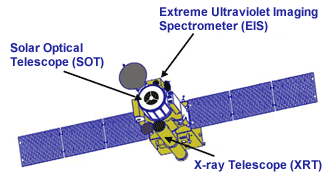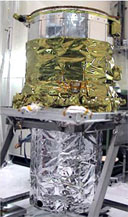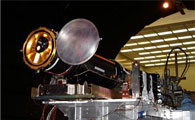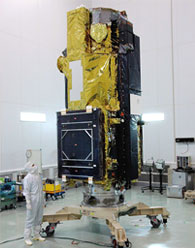Hinode is equipped with three telescopes: the Solar Optical Telescope (SOT), the X-ray Telescope (XRT), and the Extreme Ultraviolet Imaging Spectrometer (EIS).
SOT is designed to observe magnetic field vectors on the photosphere (the solar surface), and also fundamental features seen in various spectral lines in the visible light from various solar layers near the solar surface. XRT will capture X-ray images of coronal activity and heating patterns. This telescope is an upgraded version of the Soft X-ray Telescope on the X-ray Solar Observation Yohkoh, launched in 1991, with three times the resolution. XRT can cover a very wide temperature range, from less than 1 million ºC to more than 10 million ºC. EIS is an ultraviolet telescope that images the Sun using spectral lines and analyzes the spectra to study the dynamics, temperature, and density of the corona in detail. This is called plasma diagnosis.
Pointing these three telescopes at the same spots, Hinode can investigate the solar surface and corona at the same time, with the highest resolution ever achieved. We will make detailed measurements of the magnetic fields on the Sun's surface, and by comparing and analyzing these images with the eruptive phenomena in the corona and the results of plasma diagnosis, we'll be able to see what is really going on in the Sun's atmosphere and partly inside the Sun. We will also be able to study the characteristics of magnetic field lines that can pierce through the solar corona, and their state and shape when they cause explosions. This is indeed the first attempt to equip a single satellite with three telescopes with different capabilities that will observe the same locations on the Sun simultaneously.


Solar Optical Telescope (SOT)

Extreme Ultraviolet Imaging
Spectrometer (EIS)

X-ray Telescope (XRT)
Hinode is a joint project between Japan, the United States and European countries, and all three of its telescopes were built through international collaboration. Japan was in charge of the Optical Telescope Assembly and the United States provided the Focal Plane Package for SOT. For XRT, the telescope body was built in the United States, and the CCD camera in Japan. The United Kingdom was the integrator of EIS, with optical components provided by the United States. Most of the data will be transmitted from Hinode to a station in Norway, thanks to the European Space Agency (ESA). In Japan, the project team was formed primarily of members of ISAS/JAXA and the National Astronomical Observation of Japan, with experiences of the latter in developing the Subaru Telescope fully utilized.
Before the Hinode project started in 1999, we had begun preliminary research to develop a material that holds telescope tubes without deformation in extreme heat. With solar Observations, satellites are influenced by the Sun's strong light and heat, so if the telescope tube's material is not of extremely low thermal expansion, the heat will change the focal distance, affecting the accuracy of the Observations. It was very difficult to develop a new material that can accommodate temperature changes.
Another challenge we had was vibration. Orbiting satellites are never completely still, but normally their motion can be ignored, as it's very subtle. But when imaging at a resolution of 0.2 arcseconds, even a minor vibration of the telescope will introduce inaccuracies. Finally, we succeeded in developing technology that can fix any vibration and give us clear, high-resolution images.
These are just a few of the many new technologies that were developed for Hinode. Collaboration was strongly encouraged in the design process, which was transparent to all participating countries. In production, each country took charge of the area where it was strongest. Although there were some limitations due to concern about leaking technical information - and in fact this was an obstacle to the project's progress - collaborative development was very successful after all.

The Solar Observation Satellite Hinode